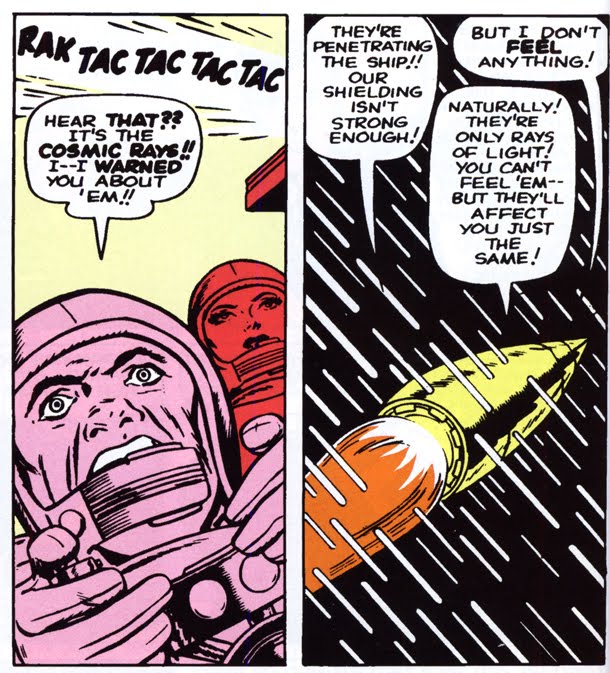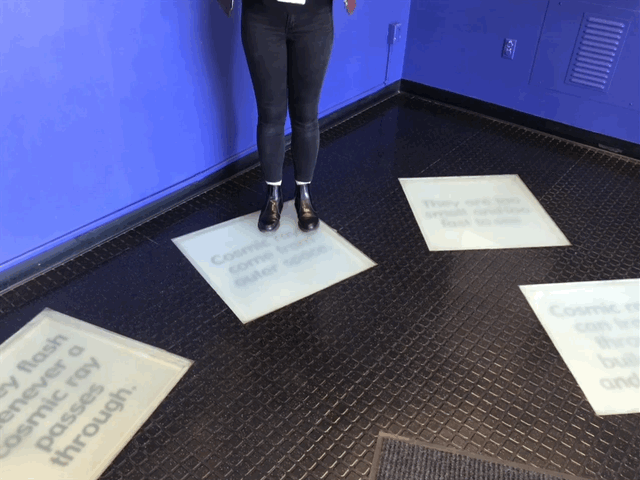When I first started writing this blog post, I was nervous because there’s something about Cosmic Rays that really freaks people out. I mean, why wouldn’t they? Who wants to think about rays from space constantly bombarding earth, passing through your body?
When you stand and watch the Cosmic Dance tiles in WonderLab’s lobby, you realize how often these “rays” really make contact. The five panels in the lobby each contain a cosmic ray detector, and light up when a ray hits them.
In popular culture, cosmic rays are credited with giving the Fantastic Four their powers. They are rumored to affect everything from cell phones to airplanes to the human body. But what exactly are cosmic rays?
Well, first of all, cosmic rays aren’t actually “rays”, they’re high-energy particles moving at almost the speed of light. The particles get accelerated to a high velocity
They were discovered by Victor Hess in 1912 when he took an electroscope, a device that 
At the time, scientists believed that the radiation came from rocks in the earth. Hess intended to test this theory by ascending in his balloon while measuring the amount of radiation. If it decreased with altitude, the theory might be true.
Hess’s first attempts to detect a difference in radiation weren’t successful. Even after climbing 1,100 meters he still detected the same value as ground level. However, when he rose to an altitude of 5,300 meters he found that radiation was three times that at sea level.
This baffled Hess, and he concluded that the cause of the radiation must have been entering Earth’s atmosphere from above!
Hess didn’t know it then, but he had just discovered cosmic rays.
Since then we have learned a lot about cosmic rays. We know that they are probably produced by the high-energy explosions of supernovae. The giant explosion pushes out a wave of gas and remnants, and particles bounce around in the cloud and accelerate, kind of like in a pinball machine.
Because the particles are moving so fast, they gain a massive amount of energy, then go hurtling through space. Many of them don’t ever reach us here on earth, but the ones that do are mostly a type of particle called a “muon.”
(The muons that reach us on earth are moving so fast that they actually defy classical laws of physics, but I digress.)
The muons fall to earth, where they can be detected by us. This whole process can be seen in 30 seconds in this short animation.
But no matter how much we learn about cosmic rays, there are still mysteries. For example, because the particles bounce around so much before they are detected on Earth, we can’t track their path. So even though we can detect and learn about the particles, their precise origins are unknown.
So, are they dangerous?
Here on Earth, something called the magnetosphere, made up of Earth’s magnetic field, protects us. Think of the magnetosphere as a big “invisible shield” around Earth. It defends us not only from cosmic rays, but also from solar wind and storms.
Earthlings, have no fear. We are safe and sound from cosmic rays. No tin foil hat necessary!
Harper Humphrey is a 21-year-old who hopes to communicate her love of science through intelligent, witty writing. She is pursuing a double major from Indiana University in Astronomy and Journalism. In her spare time she builds sets for the Indiana University opera program and experiments with her crock pot. She loves explaining physics to her friends and scaring them with stories about cosmic rays (just kidding).




Leave A Comment